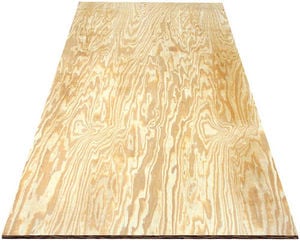Introduction
This page describes VOC levels in plywood, which is a standard United States of America home construction material.
Plywood is the one of the main types of wood in the construction of our houses. It has remained popular in United States construction due to it's strong structure, durability, and ease of use. It is commonly used as flooring,siding and other frame work. Its structure of plywood is interesting as it uses thin cut wood, veneer as they can be called. These veneers are glued using the grain of the wood's properties to add strength, as they are glued at right angles of the opposing sheet or veneer. Although the wood is glued together with an adhesive containing formaldehyde.

Adhesive resins have been used since the 1870's when they were accidentally discovered. These resins have become increasing cheaper and gained more use with the consumer surplus in the 1950's and invention of particle board. Particle board is similar to plywood, it is composed of small chips of wood that are pressed together bonding with formaldehyde resins. Particle board usually is found inside the house as it cannot handle moisture as well as plywood. It also does not have the strength that plywood has instead particle boards can be commonly found as the basis for cabinets and furniture.
The major dilemma with the use of the resin is the slow release of formaldehyde as the bonds break apart due to heat and moisture. [1] According to the Environmental Protection Agency,Formaldehyde is "a colorless, pungent-smelling gas, can cause watery eyes, burning sensations in the eyes and throat, nausea, and difficulty in breathing in some humans exposed at elevated levels (above 0.1 parts per million). High concentrations may trigger attacks in people with asthma. There is evidence that some people can develop a sensitivity to formaldehyde. It has also been shown to cause cancer in animals and may cause cancer in humans. Health effects include eye, nose, and throat irritation; wheezing and coughing; fatigue; skin rash; severe allergic reactions. May cause cancer."[2]
Use and Consumption
"U.S. demand for hardwood plywood is principally derived from demand for cabinets, furniture, store fixtures, recreational vehicles, and manufactured homes as well as U.S," according to the united states intentional trade commission.[3] A Majority of the plywood is made from domestic wood, although their are imports "U.S. firms purchased 72 percent of their wood from domestic sources and 19 percent from Canadian sources,[3] in 2006.
| US plywood Consumption | 2003 | 2005 | 2007 |
|---|---|---|---|
| Millions of dollars | 1,745 | 2,275 | 2,412 |
| Millions of square feet | 3,428 | 4,397 | 3,954 |
VOC Levels
The main VOC that is tested in plywood is formaldehyde. It can either be measured by the amount of formaldehyde realeased from the product measured in parts per million or amount in the product usually mearsured in mg/g.
| Current Regulations | Formaldehyde Emission |
|---|---|
| Department of Housing and Urban Development | 0.3 ppm |
| American National Standards Institute | 0.2 ppm |
| German Standard | 0.1 ppm |
COMPARISON TABLE OF PRODUCTS AND THEIR RELATIVE VOCS (ANYTHING ELSE? COSTS MAYBE?). MAKE THIS TABLE SORTABLE (SEE Help:Tables)
Products
The product choice is up to the consumer. Many companies do not show the amount of Formaldehyde levels in their plywood or particleboard. Some companies like Columbia Forest Products advertise their ability to create comparable products without the use of formaldehyde resins.[1] Their product is available for purchase at most home depots. The adesive that is used is a soy-based, this came after a University of Oregon professor tried to mimiic the actions of musscles. Muscles can remian attached to rocks
See Also
- LINK TO THE OTHER VOC IN STANDARD CONSTRUCTION MATERIAL PAGES
- Overview of VOCs in the household http://www.fpl.fs.fed.us/documnts/pdf1997/bauma97a.pdf
- A FEW LINKS TO OTHER RELEVANT SITES OR INFO
- Plywood basics http://en.wikipedia.org/wiki/Plywood